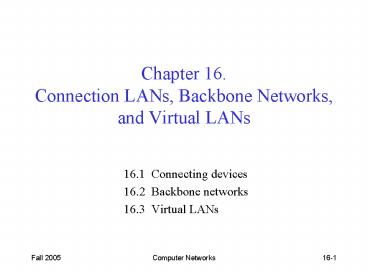Chapter 16' Connection LANs, Backbone Networks, and Virtual LANs - PowerPoint PPT Presentation
1 / 23
Title:
Chapter 16' Connection LANs, Backbone Networks, and Virtual LANs
Description:
The repeater is a two-port device that extends the LANs' physical length. Fall 2005 ... Bridges Connecting Different LANs. Different protocols at the data link ... – PowerPoint PPT presentation
Number of Views:189
Avg rating:3.0/5.0
Title: Chapter 16' Connection LANs, Backbone Networks, and Virtual LANs
1
Chapter 16. Connection LANs, Backbone Networks,
and Virtual LANs
- 16.1 Connecting devices
- 16.2 Backbone networks
- 16.3 Virtual LANs
2
Connecting Devices
3
Repeater
- A repeater operates only in the physical layers
- A repeater connects segments of a LAN
- A repeater forwards every frame it has no
filtering capability - The repeater is a two-port device that extends
the LANs physical length
4
Function of a Repeater
- A repeater is a regenerator, not an amplifier
5
Hubs
- A hub is a multiport repeater
- It is normally used to create connections between
stations in a star topology - Hubs can also be used to create multiple levels
of hierarchy
6
Repeaters/Hubs
7
Bridges
- A bridge operates in both physical and data link
layers - A bridge has filtering capability
- A bridge has a table used in filtering decisions
- A bridge can check and does not change the
physical (MAC) address in a frame
8
Bridges
- Transparent bridges
- A bridge in which the stations are completely
unaware of the bridges existence - Three criteria for a transparent bridge
- Frames must forward from one station to another
- The forwarding table is automatically made by
learning frame movements in the network - Loops in the system must be prevented
- Source routing bridges
- A sending station defines the bridges that the
frame must visit - Not very common today
- It can prevent loops in a system with redundant
bridges
9
Transparent Bridges Learning
10
Loop Problem
11
Transparent Bridges Spanning Tree
- Spanning tree is a graph in which there is no
loop - To solve the looping problem, IEEE spec requires
that bridges use the spanning tree algorithm - Select the root bridge
- The one with the smallest ID
- Select the root port of each bridge
- The port with the least-cost path from the bridge
to the root bridge - Choose a designated bridge for each LAN
- The bridge with the least-cost path from the LAN
to the root bridge - The corresponding port is the designated port
- 4. Mark the root port and designated port as
forwarding port, others as blocking port
12
Spanning Tree Algorithm Example
? root port ?? designated port
13
Bridges Connecting Different LANs
- Different protocols at the data link layer
- Frame format
- Maximum data size
- Data rate
- Bit order
- Security
- Multimedia support and QoS
14
Layer 2 Switch
- Layer 2 switch is an N-port bridge
- Ethernet switch or LAN switch
- Switched Ethernet (?)
- Full-duplex switched Ethernet (?)
15
Layer 2 and Layer 3 Switch
- Layer 2 Switching bridge
- Switching based on MAC destination address
- Builds switching table by learning host
addresses from source addresses of incoming
packets - Unknown destination addresses are flooded out
other ports - Broadcast frames are flooded out other ports
- Routing
- Switching based on IP (network layer) destination
address. - Builds routing table by neighbor routers using
routing protocols - Unknown IP packets are discarded
- Broadcast frames are discarded
- Layer 3 switching a kind of router
- Hardware-based routing
16
Broadcast and Collision Domains
17
LAN Segmentation
18
Bus Backbone
- The topology of the backbone is a bus
- To connect different buildings in an organization
19
Star Backbone
- Collapsed or switched backbone
- The topology of the backbone is a star the
backbone is just one switch - Mostly used as a distribution backbone inside a
building
20
Connecting Remote LANs
- When a company has several offices with LANs
- Remote bridges
- The point-to-point network is considered a LAN
without stations
21
Virtual LANs
- LAN configured by software, not by physical
wiring - VLANs create broadcast domains
22
Example
- Membership is characterized by port numbers, MAC
addresses, IP addresses, or a combination of the
above
23
VLAN
- Membership
- Membership is characterized by port numbers, MAC
addresses, IP addresses, Multicast IP addresses,
or a combination of the above - Configuration
- VLAN can be configured in one of three ways
manual, semiautomatic, and automatic - Communication between switches
- Each switch must know not only which station
belongs to which VLAN, but also the membership of
stations connected to other switches - Three methods are devised table maintenance,
frame tagging, and TDM - Advantages of VLAN
- Cost and time reduction
- Creating virtual workgroups
- Security































